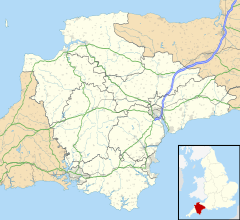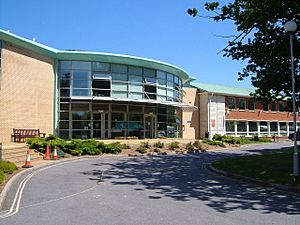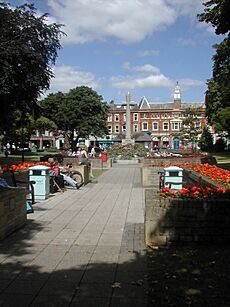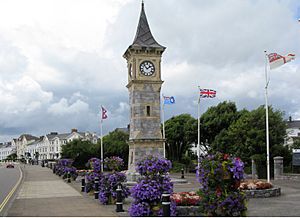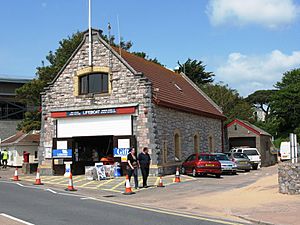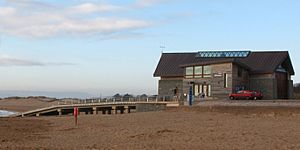Exmouth facts for kids
Quick facts for kids Exmouth |
|
|---|---|
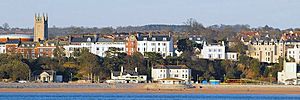 Exmouth seafront (June 2007) |
|
 Coat of arms |
|
| Population | 35,488 (2021 Census) |
| OS grid reference | SY004809 |
| Civil parish |
|
| District |
|
| Shire county | |
| Region | |
| Country | England |
| Sovereign state | United Kingdom |
| Post town | EXMOUTH |
| Postcode district | EX8 |
| Dialling code | 01395 |
| Police | Devon and Cornwall |
| Fire | Devon and Somerset |
| Ambulance | South Western |
| EU Parliament | South West England |
| UK Parliament |
|
Exmouth is a lively seaside resort town located in Devon, England. It sits right where the River Exe meets the sea, about 11 miles (18 km) southeast of Exeter.
Exmouth is a popular place for holidays and is also a busy port town. In 2021, about 35,488 people lived here, making it one of the biggest towns in Devon.
Contents
- A Look Back: Exmouth's History
- Exmouth's Buildings and Style
- What Exmouth is Known For
- Learning in Exmouth
- Exmouth's Location and Landscape
- Famous Spots in Exmouth
- Exmouth's Lifeboats
- Changes and Improvements in Exmouth
- Churches in Exmouth
- Sports and Fun in Exmouth
- Local News and Entertainment
- Getting Around Exmouth
- Famous People from Exmouth
- Exmouth's Weather
- Images for kids
- See also
A Look Back: Exmouth's History
How Old is Exmouth?
People have lived in the Exmouth area for a very long time! In 1970, ancient Byzantine coins from around 498–518 AD were found on the beach. This shows that people were visiting or living here even back then.
The earliest known name for Exmouth Point was Lydwicnaesse, which means "the point of the Bretons." This name was used in the 11th century.
The Town's Beginnings
Exmouth is made up of two older areas called Littleham and Withycombe Raleigh. These places have been around since before Saxon times. The name "Exmouth" simply means "mouth of the River Exe." The word "Exe" comes from an old Celtic word for fish.
In 1240, a spot called Pratteshuthe, or "Pratt’s landing place," was sold. This was where the ferry crossed the river. Over time, this area became known as Mona Island. Today, a seating area near the Glenorchy United Reformed Church marks this historic spot.
Developing as a Port
For many years, it was hard for large ships to use Exmouth's port because the water was shallow. Also, the city of Exeter controlled all the river traffic, which limited trade in Exmouth.
A proper dock was built in 1825, replacing older, smaller docks. Later, in 1868, new docks were opened. These new docks were connected to the railway, making it easier to move goods. The area around the docks, once home to many small chalets, is now a modern marina called Exmouth Quay.
Exmouth Becomes a Holiday Spot
In the 13th century, Exmouth started to grow. A man named John the Miller built a windmill here, using the strong winds from the sea. This windmill, along with the ferry and a few farms, helped the settlement of Exmouth develop.
Famous explorer Sir Walter Raleigh (born in 1544) sailed from Exmouth Harbour on many of his voyages.
In the mid-1600s, the coast of Devon and Cornwall faced attacks from "Turkish pirates" (who were actually Algerian raiders). They would attack ships and try to capture sailors and villagers to sell them as slaves.
Exmouth became known as a holiday resort in the 18th century, making it the oldest holiday town in Devon. When people couldn't travel to Europe because of the French Revolution, they came to Exmouth. They loved the beautiful views and the fashionable "medicinal salt waters." Wealthy people visited Exmouth to get better when they were sick. Famous visitors included Lady Byron and her daughter Ada Lovelace. Lady Nelson, the wife of Lord Nelson, also lived in Exmouth and is buried in Littleham Churchyard.
When the first railway line reached Exmouth in 1861, it brought many more visitors. This "golden age" of tourism helped shape the town we see today.
Exmouth's Buildings and Style
Exmouth has many different kinds of buildings. You can find old stone cottages in areas that used to be separate villages, like Withycombe. There are also grand Georgian, Victorian, and Edwardian houses.
The seafront has a traditional promenade where people can walk. High above the promenade is the Beacon terrace, which became popular in Georgian times. Most of Exmouth's buildings were built during the Victorian era, especially after the railway arrived. Some houses near the station were even built for the railway workers.
What Exmouth is Known For
Fun Activities and Nature
Exmouth is a great place for holidays and is a hub for fun activities. It's especially popular for water sports like sailing, kite sailing, paddleboarding, jet-skiing, and wind-surfing. You can also enjoy outdoor activities like bird-watching, cycling, and walking.
The Exe Estuary is a special place for nature, known for its many wading and migrating birds. A large part of the estuary is a nature reserve.
Exmouth is also the start of the Jurassic Coast World Heritage Site. This amazing coastline stretches eastwards to Poole in Dorset. The South West Coast Path lets you walk along this beautiful coast. Exmouth is also the western end of the East Devon Way path, which goes to Lyme Regis.
Learning in Exmouth
Exmouth has eight primary schools, one secondary school, and a school specifically for deaf students.
Primary schools include:
- Bassett's Farm Primary School
- Brixington Primary School
- Exeter Road Community Primary School
- Littleham Church of England Primary School
- Marpool Primary School
- St Joseph's Catholic Primary School
- The Beacon CofE (VA) Primary School
- Withycombe Raleigh Church of England Primary School
The main secondary school is Exmouth Community College. In 2013, it had 2,615 students aged 11 to 18.
The Deaf Academy is a special school for deaf students aged 5 to 16, with further education options for older students. It also has places for students to live. The school moved to Exmouth in 2020, creating a modern center for deaf education.
This site used to be Rolle College, which opened in 1946 and later became part of the University of Plymouth. The university closed the college in 2008.
Exmouth's Location and Landscape
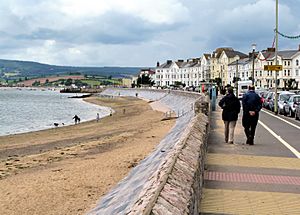
Exmouth is shaped by its sea and river fronts, each about a mile long. The town stretches inland for about 2.5 miles (4 km). The docks are in the western part of town, where the river meets the sea. The mouth of the estuary is almost closed by Dawlish Warren, a natural sand spit on the other side of the river. Dawlish Warren is home to rare wildlife and plants, and part of it is a nature reserve.
Exmouth has a sandy beach that is two miles long. At its eastern end, the town is bordered by the cliffs of the High Land of Orcombe. This area is owned by the National Trust and rises to a peak at Orcombe Point.
The low hill in the center of Exmouth, called "The Beacon," is made of a type of rock called breccia. The land where the town has grown is made of New Red Sandstone. The town is surrounded by mudflats and sandspits. Some of these have been made stable and are now part of the town's land. Others remain as tidal features in the estuary and off the coast.
Famous Spots in Exmouth
On the northern edge of Exmouth, you can find A La Ronde. This unique 18th-century house has 16 sides and is now owned by the National Trust. At the eastern end of town is the Barn, a late 19th-century house built in the Arts and Crafts style.
The National Coastwatch Institution Tower on the seafront is a well-known landmark. This red brick building was finished in 1896. It was first used as a race observation tower for the Exmouth Yacht Club, offering great views of races. Over the years, it has been a bathing house, a private home, and a place for people to recover from illness. During World War II, it was a lookout station for the war effort.
Since 1998, volunteers from the National Coastwatch Institution have staffed the tower. They act as "eyes and ears" for the coast, watching for anyone in trouble and any dangers in the water, working alongside the Coastguard and RNLI.
Exmouth's Lifeboats
Exmouth has had a lifeboat since 1803. The first boathouse was built near Passage House but was destroyed in a storm in 1814. The Royal National Lifeboat Institution (RNLI) brought the lifeboat station back in 1858. A new boathouse was built on the beach.
In 1903, a larger boathouse was built on the same spot for a bigger lifeboat. From 1961, the lifeboat was kept in the river near Exmouth Docks. A smaller boat was used to take the crew to the lifeboat. The old boathouse on the beach became a display center and, from 1966, was home to an inshore lifeboat.
On November 21, 2009, both lifeboats moved to a new lifeboat station on Queen's Drive, at the eastern end of the beach. Inside the new station, there is a sign from the old Volunteer Inn. This pub was run by Will Carder, who sadly drowned on Christmas Day in 1956 during a rescue mission. This was a very sad day for Exmouth RNLI.
From this station, the RNLI operates a Shannon Class all-weather lifeboat (ALB) called R and J Welburn. They also have an Inshore Lifeboat (ILB) named George Bearman II, which replaced the original George Bearman in 2017.
The old boathouse was used by RNLI lifeguards until 2014. Now, it is the home of the Exmouth Rowing Club.
Changes and Improvements in Exmouth
Around 2012, £3 million was spent to improve an area called the Strand. This project removed much of the grass and flower beds. New features include more seating and bicycle storage. The area is now completely for people walking, with no cars allowed. The Strand was partly open for Remembrance Sunday in 2010, with the war memorial area finished.
Churches in Exmouth
Exmouth has many active churches. Holy Trinity Church, a parish of the Church of England, was built in 1824-25. It was paid for by Lord Rolle and cost £13,000. It is a beautiful building with a tower 104 feet high. The church can seat 1,500 people. Before this church was built, Exmouth did not have an official Church of England place of worship.
Other active churches in Exmouth include Christ Church Exmouth, Hope Church, Glenorchy United Reformed Church, Tower Street Methodist Church, Ichthus Community Church, Holy Ghost Roman Catholic Church, Exmouth Baptist Church, and Exmouth Salvation Army.
Sports and Fun in Exmouth
Exmouth has many sports teams and leisure facilities. Exmouth Town F.C. is the town's main football team. Exmouth also has two rugby union teams: Exmouth RFC and Withycombe RFC. The Polesanders Beach Rugby Club was started in 2014.
Devon County Cricket Club plays its matches at the Maer Ground, which is the home of Exmouth Cricket Club (started in 1843). This club has won many championships in the Devon Cricket League. Exmouth also has a large indoor leisure center.
Local News and Entertainment
For local TV news, Exmouth is covered by BBC South West and ITV West Country. You can get television signals from the Beacon Hill or Stockland Hill TV transmitters.
Local radio stations include BBC Radio Devon on 104.3 FM, Heart West on 97.0 FM, Greatest Hits Radio South West on 105.5 FM, and East Devon Radio, a local station on 106.4 FM.
Exmouth's local newspaper, the Exmouth Journal, comes out every Thursday.
Getting Around Exmouth
Train and Ferry Travel
Exmouth railway station is the end of the Avocet Line. Trains from Exmouth go to Exeter St David's station and then continue to Paignton. There's also a cycleway built next to the railway line that goes all the way to Exeter and beyond.
The Exmouth to Starcross Ferry is a passenger ferry that runs in the summer. It crosses the Exe estuary to Starcross. At Starcross, you can see the old pumping station for Brunel's Atmospheric Railway.
Exmouth's Railway History
Exmouth has had three different railway stations. The first train line reached Exmouth from Exeter in 1861. In just the first five days, 10,000 people rode the train, and property prices in Exmouth went up very quickly! By the 1880s, many people were traveling by train to Exeter for work.
In 1903, a link was opened to Budleigh Salterton. This line went eastward over a viaduct (a bridge-like structure) from Exeter Road to Park Road. It then went through a cutting to Littleham Cross, where there was another station. From there, it continued to Budleigh Salterton.
Exmouth Station was rebuilt in 1926. When the line to Budleigh was closed, the viaduct stayed for many years but was finally taken down in the late 1980s. Now, houses stand where it used to be.
The old railway line behind Phear Park is now a paved path for cycling and walking. It goes from Exmouth to Knowle, near Budleigh Salterton. Phear Park used to be the grounds of a large house. During World War II, American soldiers stayed there. The house later burned down, and its grounds were given to the town to become a park.
The newest Exmouth station was built in 1981 next to the bus station. It has one platform and a car park for train users.
Bus Services
Stagecoach South West runs several frequent bus services in and around Exmouth. The 57 Stagecoach Gold service goes to Brixington in one direction and to Lympstone, Topsham, and Exeter in the other. This bus runs every 15 minutes. Another popular Stagecoach service is the 95 summer service to Sandy Bay Holiday Park. This bus often uses an open-top bus and runs every hour.
Famous People from Exmouth
People from Exmouth are called Exmouthians. Many interesting people have connections to Exmouth, including:
- Alex Wade (born 1986), author
- Antonio Corbisiero (born 1984), footballer
- Conrad Humphreys (born 1973), sailor
- Ed "Stewpot" Stewart (1941–2016), radio DJ and entertainer
- Francis Danby (1793–1861) Irish-born painter
- Graham Hurley (born 1946), author
- Pam St. Clement (born 1942), actress (attended Rolle College)
- Pauline Collins (born 1940), actor
- R. F. Delderfield (1912–1972), author (moved to Exmouth in 1923)
- Rebecca Newman (born 1981), singer-songwriter
- Robin Bush (1943–2010), historian and author
- Xia Vigor (born 2009), child actress and model
Exmouth's Weather
| Climate data for Exmouth, Salterton Road (1930–1990 averages) | |||||||||||||
|---|---|---|---|---|---|---|---|---|---|---|---|---|---|
| Month | Jan | Feb | Mar | Apr | May | Jun | Jul | Aug | Sep | Oct | Nov | Dec | Year |
| Mean daily maximum °C (°F) | 9 (48) |
9 (48) |
11 (52) |
13 (55) |
17 (63) |
20 (68) |
22 (72) |
21 (70) |
19 (66) |
15 (59) |
11 (52) |
9 (48) |
15 (58) |
| Mean daily minimum °C (°F) | 3 (37) |
3 (37) |
4 (39) |
4 (39) |
7 (45) |
10 (50) |
12 (54) |
12 (54) |
10 (50) |
8 (46) |
5 (41) |
3 (37) |
7 (44) |
| Average precipitation mm (inches) | 89.1 (3.51) |
69.9 (2.75) |
68.5 (2.70) |
55.2 (2.17) |
58.0 (2.28) |
49.6 (1.95) |
48.9 (1.93) |
56.1 (2.21) |
60.1 (2.37) |
92.7 (3.65) |
88.5 (3.48) |
103.8 (4.09) |
840.4 (33.09) |
| Mean monthly sunshine hours | 62.5 | 79.8 | 126.2 | 174.9 | 210.5 | 214.5 | 210.4 | 198.6 | 152.7 | 109.3 | 75.1 | 60.0 | 1,674.5 |
Images for kids
See also
 In Spanish: Exmouth para niños
In Spanish: Exmouth para niños


